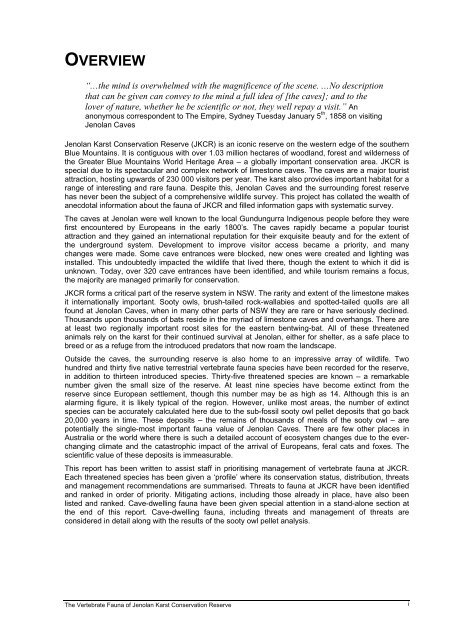The Vertebrate Fauna of Jenolan Karst Conservation Reserve: Final
The Vertebrate Fauna of Jenolan Karst Conservation Reserve: Final
The Vertebrate Fauna of Jenolan Karst Conservation Reserve: Final
You also want an ePaper? Increase the reach of your titles
YUMPU automatically turns print PDFs into web optimized ePapers that Google loves.
OVERVIEW<br />
“…the mind is overwhelmed with the magnificence <strong>of</strong> the scene. …No description<br />
that can be given can convey to the mind a full idea <strong>of</strong> [the caves]; and to the<br />
lover <strong>of</strong> nature, whether he be scientific or not, they well repay a visit.” An<br />
anonymous correspondent to <strong>The</strong> Empire, Sydney Tuesday January 5 th , 1858 on visiting<br />
<strong>Jenolan</strong> Caves<br />
<strong>Jenolan</strong> <strong>Karst</strong> <strong>Conservation</strong> <strong>Reserve</strong> (JKCR) is an iconic reserve on the western edge <strong>of</strong> the southern<br />
Blue Mountains. It is contiguous with over 1.03 million hectares <strong>of</strong> woodland, forest and wilderness <strong>of</strong><br />
the Greater Blue Mountains World Heritage Area – a globally important conservation area. JKCR is<br />
special due to its spectacular and complex network <strong>of</strong> limestone caves. <strong>The</strong> caves are a major tourist<br />
attraction, hosting upwards <strong>of</strong> 230 000 visitors per year. <strong>The</strong> karst also provides important habitat for a<br />
range <strong>of</strong> interesting and rare fauna. Despite this, <strong>Jenolan</strong> Caves and the surrounding forest reserve<br />
has never been the subject <strong>of</strong> a comprehensive wildlife survey. This project has collated the wealth <strong>of</strong><br />
anecdotal information about the fauna <strong>of</strong> JKCR and filled information gaps with systematic survey.<br />
<strong>The</strong> caves at <strong>Jenolan</strong> were well known to the local Gundungurra Indigenous people before they were<br />
first encountered by Europeans in the early 1800’s. <strong>The</strong> caves rapidly became a popular tourist<br />
attraction and they gained an international reputation for their exquisite beauty and for the extent <strong>of</strong><br />
the underground system. Development to improve visitor access became a priority, and many<br />
changes were made. Some cave entrances were blocked, new ones were created and lighting was<br />
installed. This undoubtedly impacted the wildlife that lived there, though the extent to which it did is<br />
unknown. Today, over 320 cave entrances have been identified, and while tourism remains a focus,<br />
the majority are managed primarily for conservation.<br />
JKCR forms a critical part <strong>of</strong> the reserve system in NSW. <strong>The</strong> rarity and extent <strong>of</strong> the limestone makes<br />
it internationally important. Sooty owls, brush-tailed rock-wallabies and spotted-tailed quolls are all<br />
found at <strong>Jenolan</strong> Caves, when in many other parts <strong>of</strong> NSW they are rare or have seriously declined.<br />
Thousands upon thousands <strong>of</strong> bats reside in the myriad <strong>of</strong> limestone caves and overhangs. <strong>The</strong>re are<br />
at least two regionally important roost sites for the eastern bentwing-bat. All <strong>of</strong> these threatened<br />
animals rely on the karst for their continued survival at <strong>Jenolan</strong>, either for shelter, as a safe place to<br />
breed or as a refuge from the introduced predators that now roam the landscape.<br />
Outside the caves, the surrounding reserve is also home to an impressive array <strong>of</strong> wildlife. Two<br />
hundred and thirty five native terrestrial vertebrate fauna species have been recorded for the reserve,<br />
in addition to thirteen introduced species. Thirty-five threatened species are known – a remarkable<br />
number given the small size <strong>of</strong> the reserve. At least nine species have become extinct from the<br />
reserve since European settlement, though this number may be as high as 14. Although this is an<br />
alarming figure, it is likely typical <strong>of</strong> the region. However, unlike most areas, the number <strong>of</strong> extinct<br />
species can be accurately calculated here due to the sub-fossil sooty owl pellet deposits that go back<br />
20,000 years in time. <strong>The</strong>se deposits – the remains <strong>of</strong> thousands <strong>of</strong> meals <strong>of</strong> the sooty owl – are<br />
potentially the single-most important fauna value <strong>of</strong> <strong>Jenolan</strong> Caves. <strong>The</strong>re are few other places in<br />
Australia or the world where there is such a detailed account <strong>of</strong> ecosystem changes due to the everchanging<br />
climate and the catastrophic impact <strong>of</strong> the arrival <strong>of</strong> Europeans, feral cats and foxes. <strong>The</strong><br />
scientific value <strong>of</strong> these deposits is immeasurable.<br />
This report has been written to assist staff in prioritising management <strong>of</strong> vertebrate fauna at JKCR.<br />
Each threatened species has been given a ‘pr<strong>of</strong>ile’ where its conservation status, distribution, threats<br />
and management recommendations are summarised. Threats to fauna at JKCR have been identified<br />
and ranked in order <strong>of</strong> priority. Mitigating actions, including those already in place, have also been<br />
listed and ranked. Cave-dwelling fauna have been given special attention in a stand-alone section at<br />
the end <strong>of</strong> this report. Cave-dwelling fauna, including threats and management <strong>of</strong> threats are<br />
considered in detail along with the results <strong>of</strong> the sooty owl pellet analysis.<br />
<strong>The</strong> <strong>Vertebrate</strong> <strong>Fauna</strong> <strong>of</strong> <strong>Jenolan</strong> <strong>Karst</strong> <strong>Conservation</strong> <strong>Reserve</strong><br />
i

















